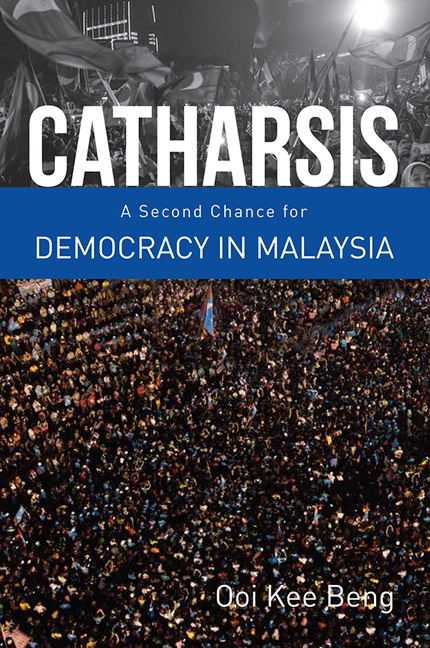Book contents
- Frontmatter
- Contents
- Foreword
- 1 Introduction – Malaysia's Future Is Redeemed
- Before Pakatan Harapan
- Before 9 May 2018
- With Mahathir at the Helm
- 31 One Thing Is Certain—There Will Be More Amendments to the Constitution
- 32 The More Things Change, the More Things May Actually Change
- 33 Did Merdeka Liberate or Create Malaya?
- 34 Interview with Nurul Izzah Anwar: Rebuilding a Nation Long Divided
- 35 The Diminishing of Humans Through Identity Politics
- 36 The Art of Dismantling Cultural Pluralism
- 37 No Need to Let Bigots Dictate Policy
- 38 What the Penang Floods Say About Malaysian Politics (and It's Not Just About Climate Change)
- 39 This is the Moment of Truth for Malaysia's Race-based Politics
- 40 We are Equal Only Through Our Vote
- 41 Why the Opposition Has a Shot at Toppling the Barisan Nasional with Mahathir at the Helm
- 42 Spiralling Back towards Reformasi
- 43 Individual Freedom Is a Matter of National Survival
- 44 Why Meet the Twenty-first Century with Twentieth Century Mindsets?
- 45 A Final Quarrel between a Repentant Grandfather and Oldfashioned Self-absorbed Parents
- 46 Outraged Enough to Go Vote or Cynical Enough to Stay Home?
- Beyond 9 May 2018
- About the Author
39 - This is the Moment of Truth for Malaysia's Race-based Politics
from With Mahathir at the Helm
Published online by Cambridge University Press: 12 February 2019
- Frontmatter
- Contents
- Foreword
- 1 Introduction – Malaysia's Future Is Redeemed
- Before Pakatan Harapan
- Before 9 May 2018
- With Mahathir at the Helm
- 31 One Thing Is Certain—There Will Be More Amendments to the Constitution
- 32 The More Things Change, the More Things May Actually Change
- 33 Did Merdeka Liberate or Create Malaya?
- 34 Interview with Nurul Izzah Anwar: Rebuilding a Nation Long Divided
- 35 The Diminishing of Humans Through Identity Politics
- 36 The Art of Dismantling Cultural Pluralism
- 37 No Need to Let Bigots Dictate Policy
- 38 What the Penang Floods Say About Malaysian Politics (and It's Not Just About Climate Change)
- 39 This is the Moment of Truth for Malaysia's Race-based Politics
- 40 We are Equal Only Through Our Vote
- 41 Why the Opposition Has a Shot at Toppling the Barisan Nasional with Mahathir at the Helm
- 42 Spiralling Back towards Reformasi
- 43 Individual Freedom Is a Matter of National Survival
- 44 Why Meet the Twenty-first Century with Twentieth Century Mindsets?
- 45 A Final Quarrel between a Repentant Grandfather and Oldfashioned Self-absorbed Parents
- 46 Outraged Enough to Go Vote or Cynical Enough to Stay Home?
- Beyond 9 May 2018
- About the Author
Summary
After all the analysing done by pundits on Malaysia's political dynamics in the post-Mahathir period, the country has now come to the strange point of being in a potential pre-Mahathir period.
There is now the more-than-theoretical possibility that 92-yearold former Prime Minister Mahathir Mohamad will return to lead the country, should the opposition coalition win the coming general election. Though unlikely, the chances of that happening are not exactly slim.
In many ways, Malaysia has been locked in a period of transition for two decades. One could say this was triggered by the Reformasi movement in 1998 when the country's two top leaders fell out with each other and behind that, by the socio-economic travails ignited by the Asian Financial Crisis; or one could claim that it began with Mahathir's retirement in October 2003; or that it started with the surprising results of the 2008 elections when the ragtag opposition managed on election night to win five of the 13 states.
Behind these unending trends lies the fact that a new generation of young leaders – some inspired by the 1998 protests but most thrust into the limelight in 2008, have been waiting impatiently to take over but are still playing merely a supporting role, not only because the old leaders are still active but also because of the solidity of the discursive and economic domination of the ruling Barisan Nasional coalition over the rural population in particular.
Then there was the advent of Internet news media, a prominent milestone of which was the founding of the Malaysiakini news website in 1999. This was followed a decade later by The Malaysia Insider (brought to its knees by political pressure in 2016 and since resurrected as The Malaysian Insight) and by other websites. Social media also appeared after the turn of the century to act as an effective new tool for political activism.
Where the opposition parties are concerned, we have seen its major coalitions evolve from the Barisan Alternatif in 1999 to Pakatan Rakyat in April 2008 to Pakatan Harapan in 2015, which since then has evolved to include two newly formed Malay-based parties: Parti Amanah Negara (splintered from the Islamist Parti Agama SeMalaysia, or PAS) and Mahathir's Parti Pribumi Bersatu Malaysia (consisting of UMNO dissidents).
- Type
- Chapter
- Information
- CatharsisA Second Chance for Democracy in Malaysia, pp. 149 - 152Publisher: ISEAS–Yusof Ishak InstitutePrint publication year: 2018



